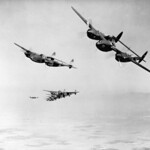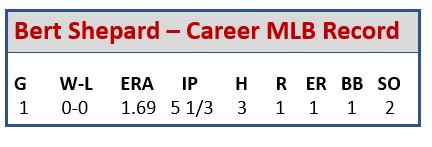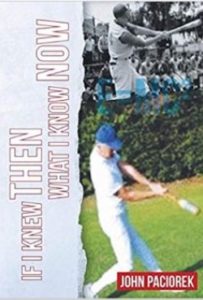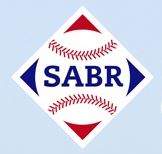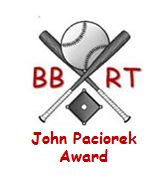 In 2014, Baseball Roundtable launched the John Paciorek Award (JPA). The JPA recognizes players who have had short, often very short, major league careers, but whose accomplishments, nonetheless, deserve recognition. Past winners have included a player whose every MLB hit (three in nine career at bats) was a home run; a player who had only one MLB at bat, but earned a World Series ring and a Purple Heart; a player who had just two home runs in 61 MLB at bats (for the vaunted Yankees and Dodgers), but whose “body of work” made him one of just two players in MLB history to homer in their first and final official appearances in a major league batter’s box; and more. (Note: Information on John Paciorek’s career – the inspiration for the JPA – can be found at the end of this post. Paciorek’s day in the sun constitutes arguably the best one-game MLB career ever.)
In 2014, Baseball Roundtable launched the John Paciorek Award (JPA). The JPA recognizes players who have had short, often very short, major league careers, but whose accomplishments, nonetheless, deserve recognition. Past winners have included a player whose every MLB hit (three in nine career at bats) was a home run; a player who had only one MLB at bat, but earned a World Series ring and a Purple Heart; a player who had just two home runs in 61 MLB at bats (for the vaunted Yankees and Dodgers), but whose “body of work” made him one of just two players in MLB history to homer in their first and final official appearances in a major league batter’s box; and more. (Note: Information on John Paciorek’s career – the inspiration for the JPA – can be found at the end of this post. Paciorek’s day in the sun constitutes arguably the best one-game MLB career ever.)
For 2020, given the circumstances across our nation and around the globe. Baseball Roundtable decided to look for a major-league short-timer who exemplified heroism – and who exhibited courage, commitment, perseverance and high spirits in the face of adversity. Let me diverge for a moment here and thank today’s heroes – those who are (still) working to respond to our health care needs, keep us safe or make our lives as comfortable/normal as possible. You know who I’m talking about: medical professionals and support staff; first responders (police, fire, paramedic); big rig drivers; shipping and delivery workers; postal employees; grocery store workers; public transit workers; restaurant staff. I’m sure I missed some, but to all of those working hard for all of us, thank you for the risks you take and the services/comfort you provide. And, a thought for the day, let’s all say thank you to – and tip – these people whenever we can.
Now let’s take a look at this year’s John Paciorek Award winner – an individual who showed tremendous courage, commitment to duty, perseverance and endurance in the face of adversity – qualities we can all use right now. This year’s JPA honorees was a true hero both off and on the baseball diamond.
—-BASEBALL ROUNDTABLE 2020 JOHN PACIOREK AWARD HONOREE —-
BERT SHEPARD
Robert “Bert” Shepard was born and raised in western Indiana – a natural athlete who, during his high school years, played basketball and football, as well as semipro baseball (his high school did not have a baseball team). His dream? To become a professional baseball player. Little did he know that his pursuit of that dream would be interrupted by a global conflict.
In 1939, Shepard signed a minor-league deal with the White Sox. Over the next four seasons (1939-42) he played for six minor-league teams, never rising above Class C. While he often showed good stuff, Shepard had control issues. In his best season, 1942 (by this time in the Cardinals’ system), Shepard went 9-13, 4.45 – but walked 122 batters in 172 innings. With Shepard still working on his command, World War II came calling with a different kind of command.
In 1943, Shepard interrupted his baseball pursuits to enlist in the U.S. Army, where his natural athleticism helped him earn a commission as a P-38 Lightning fighter pilot. Stationed out of England, Shepard flew more than thirty combat missions. On May 21, 1944, a critical air attack on an airfield near Hamburg, Germany was in the works and, although he was not scheduled to take part, Shepard volunteered for the mission (which would prove to be 34th and final combat flight). On the return from the attack, Shepard’s plane was shot down and he was injured and captured. His wounds required the amputation of his right leg below the knee.
While he was a Prisoner of War, a fellow prisoner (a Canadian medic) cobbled together an artificial lower leg for Shepard (out of scrap metal, wood and leather) and Shepard actually pitched in Stalag cricket matches using the makeshift prosthesis. After eight months as a P.O.W., Shepard was released as part of a prisoner exchange. Shortly after his return, Shepard he began practicing with a local semipro team – noting that he was lucky his prosthesis was on his right leg, since (as a southpaw) it was his landing leg rather than his push-off limb.
Bert Shepard’s World War II heroism earned him the Distinguished Flying Cross,
Air Medal and Purple Heart.
Then came a lucky coincidence. Shepard, while being fitted for a new leg at Walter Reed Hospital, was fortunate enough to be visited by Undersecretary of War Robert Patterson – who just happened to be a baseball fan and friend of Washington Senators owner Clark Griffith. In his conversation with Patterson, Shepard mentioned his desire (and commitment), despite his injuries, to once again play professional baseball. Patterson relayed Shepard’s comments to Griffith, who brought the decorated veteran in for a tryout and signed him to serve as a coach and batting practice pitcher – and to take the mound in the occasional exhibition games (where Shepard acquitted himself well). After an effective four-inning outing against the Dodgers in a July 1945 exhibition (raising funds for the War Relief effort), Shepard was added to the Senators’ active roster. Another step toward his major-league dream.
Bert Shepard made many visits to veterans hospitals, made a training film for amputees and was an inspiration for injured veterans – which may be exactly what Undersecretary of War Robert Patterson and Washington Senators owner Clark Griffith had in mind.
While Shepard was on the Senators’ active roster, the team was involved in a tight pennants race (the club would finish 1 ½ games behind the AL Champion Tigers) and manager Ossie Bluege was reluctant to use him in critical situations.
Then, on August 4, 1945, the opportunity to bring the war hero to the mound surfaced. It came with the Red Sox leading the Senators 14-2, with a runner on second and two outs in the top of the fourth. The Senators were in the second game of a double header, had already played twin bills on August, 1, 2, and 3 and were slated for another double dip on August 5. The pitching staff was beleaguered and Shepard would prove to be just what the doctors ordered.
He came into a game in which the BoSox bats were sizzling. They had already scored 12 runs (seven hits, six walks) in the inning, had a runner on second and clean-up hitter George “Catfish” Metkovich at the plate. Shepard looked comfortable on the mound and pitched as well as he ever had (maybe even better). He struck out Metkovich to end the inning – and went on to finish the game – giving up just one run over 5 1/3 frames.
It was to be Shepard’s sole MLB appearance – but it was a good one, ending in a career 1.69 ERA for the only one-legged pitcher in baseball history. Shepard was released by the Senators on September 30, 1945, but retained his passion for the game.
In 1946, with major league players now returning from military service, Shepard did not make the Senators’ active roster, but was signed as a coach. Shepard’s competitive fires were still burning however, and he asked to be sent down to the minors, where he could prove himself on the field. His control issues continued and his situation was complicated by additional surgery (to remove more of his leg) after the season. Shepard signed with the St. Louis Browns for 1947, but was released after a stint with the Elmira club of the Eastern League. Additional surgeries followed, but Shepard continued to play the game he loved – taking the minor-league mound as late as 1955, pitching in semi-pro leagues and managing in the minor leagues in 1949, 1952 and 1954.
After finally hanging up his baseball spikes, Shepard’s competitive spirit continued and he took up golf – winning the United States Amputee Gold Championship in 1968 and 1971/
Shepard passed away in 2008, at age 87.
Primary Resources: Baseball-Reference.com; Bert Shepard Society for American Baseball Research biography, by Terry Bohn; Shot Down in the Prime of Life: Bert Shepard, Who Pitched One Major League Game With One leg, Searched for years to Find Out Who Saved His Life, by Chris Dufresne, Los Angeles Times, October 6, 1995; Valor of Many Stripes, by Scott Baron, 2019. McFarland and Company; Bert Shepard, 87, Who Pitched in Majors After War Amputation Dies, by Richard Goldstein New York Times, June 20, 2008.
—- PAST JOHN PACIOREK AWARD HONOREES (with links) —-
2014 – Brian Scott Dallimore
In his first start (not his first game) for the 2004 Giants, Dallimore had two singles, a Grand Slam (his first MLB hit and only MLB home run), a walk and a hit by pitch. For the full JPA take on Dallimore’s 27- game MLB career, click here.
2015 – Roy Gleason
Gleason played in just eight MLB games, had a double in his only MLB at bat – but also earned a World Series ring (1963) and a Purple Heart. Ultimately, he was the only ballplayer with MLB experience to serve on the front lines in Vietnam. For the full JPA take on Gleason, click here. Note: Gleason’s life is detailed in the book “Lost in the Sun – Roy Gleason’s Odyssey from the Outfield to the Battlefield.”
2016 – John Allen Miller
Miller played just 32 MLB games (during the 1966 and 1969), taking the field (at 1B/LF/3B/2B) for the Yankees and Dodgers. Miller collected ten hits in 61 MLB at bats (.164 average) and hit just two home runs – but he made those long balls count. Miller made his MLB debut with the Yankees on September 11, 1966 and hit a two-run homer in his first big league at bat – making him (surprisingly) the first Yankee ever to homer in his first MLB at bat. (Little did Miller know he would not get another home run or RBI until the final at bat of his MLB career.) Miller’s final at bat came as a Dodger (September 23, 1969) and he stroked a solo home run. That narrow “body of work” made Miller one of just two players in MLB history to homer in their first and final official appearances in a major league batter’s box. For more on Miller, click here.
2017 – Chris Saenz
RHP Chris Saenz’ big day came on April 24, 2004 – when he was called up from Double A Huntsville (where he was 1-1, 3.86) to make a spot start against the Saint Louis Cardinals, whose powerful lineup included the likes of Albert Pujols, Scott Rolen, Jim Edmonds and Reggie Sanders. The rookie went six innings, giving up just two hits, three walks and no runs, while fanning seven. There was some speculation (primarily among sportswriters and fans) that Saenz’ performance might earn him another start or two, but two days after his debut, he was on his way back to Huntsville. Unfortunately, his minor league season included a September elbow injury that required Tommy John surgery and he never returned to the majors. Statistics before 1900 can be sketchy, but baseball-reference.com shows that Saenz is the only pitcher to complete a one-game MLB career of at least five innings pitched, without giving up a single run (earned or unearned). For more details on this JPA honoree, click here.
2018 – Keith McDonald
Keith McDonald’s MLB career (Cardinals 2000-2001) covered just eight games and 11 plate appearances (nine at bats) and three hits – but he made them count. All of McDonald’s safeties were home runs – making him the only MLB player with more than one career hit who can look back on major league career in which his every hit was a home run. McDonald is also one of only two players – and the only National Leaguer – to homer in his first two major league plate appearances. For the full story, click here.
2019 – Harley Hisner
Harley Hisner’s MLB tenure encompassed the day of September 30, 1951. That’s when the 24-year-old righty faced the New York Yankees – and a lineup that included five future Hall of Famers: Mickey Mantle in RF; Joe DiMaggio in CF; Phil Rizzuto at SS; Johnny Mize at 1B; and Yogi Berra behind the plate. In is very first MLB inning, Hisner faced five batters, four of them future Hall of Famers, and gave up two singles and no runs. His place in history? One of those singles was Joe DiMaggio’s last MLB safety. He faced Mickey Mantle four times in the game – walking him once, fanning him twice and getting him to hit into a double play. Hisner’s final career stat was 0-1, 4.50, with six innings pitched, seven hits, three earned runs, four walks and three strikeouts. For more on Harley Hisner and his ongoing involvement in and love of the game (he went on to earn the Northeast Indiana Baseball Association Colin Lister Award for “dedication to the game of baseball and its historic legacy,” click here.
–—-INSPIRATION FOR THE JPA—–
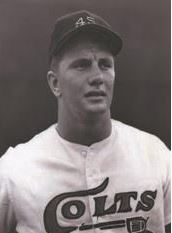 John Paciorek – signed out of Saint Ladislaus High School in Hamtramck, Michigan (where he had starred in football, basketball and baseball) – appeared in his first major league game on the final day of the 1963 season (September 29) at the age of 18. The 6’ 1”, 200-pound outfielder had spent the 1963 season with Class A Modesto Colts. The Colts’ parent club, the Houston Colt .45s (that was the current Astros’ franchise name back then), was suffering through a difficult season. The team was 65-96 going into that final game. Looking to the future, Houston had, in fact, fielded an all-rookie lineup (average age 19) on September 27. Youth was still being served two days later when John Paciorek started his first MLB game. The results were surprising – and worthy of recognition.
John Paciorek – signed out of Saint Ladislaus High School in Hamtramck, Michigan (where he had starred in football, basketball and baseball) – appeared in his first major league game on the final day of the 1963 season (September 29) at the age of 18. The 6’ 1”, 200-pound outfielder had spent the 1963 season with Class A Modesto Colts. The Colts’ parent club, the Houston Colt .45s (that was the current Astros’ franchise name back then), was suffering through a difficult season. The team was 65-96 going into that final game. Looking to the future, Houston had, in fact, fielded an all-rookie lineup (average age 19) on September 27. Youth was still being served two days later when John Paciorek started his first MLB game. The results were surprising – and worthy of recognition.
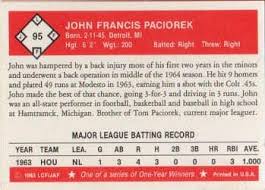 Playing right field and batting seventh in a 13-4 win over the NY Mets, Paciorek ended up with three hits and two walks in five plate appearances, with four runs scored and three runs batted in. Perhaps equally surprising is that it was not only Paciorek’s first major league appearance, it was to be his only MLB appearance. Back pain the following spring, followed by surgery (he played 49 minor league games in 1964 and missed all of the 1965 season), put an end to his MLB playing days. (Paciorek did play in four more minor league seasons.) Still, you will find John Paciorek in the Baseball Encyclopedia and his is arguably the greatest one-game MLB career ever. Among one-gamers, he holds the record for times on base and runs scored, and shares the record for batting average, on base percentage and RBIs.
Playing right field and batting seventh in a 13-4 win over the NY Mets, Paciorek ended up with three hits and two walks in five plate appearances, with four runs scored and three runs batted in. Perhaps equally surprising is that it was not only Paciorek’s first major league appearance, it was to be his only MLB appearance. Back pain the following spring, followed by surgery (he played 49 minor league games in 1964 and missed all of the 1965 season), put an end to his MLB playing days. (Paciorek did play in four more minor league seasons.) Still, you will find John Paciorek in the Baseball Encyclopedia and his is arguably the greatest one-game MLB career ever. Among one-gamers, he holds the record for times on base and runs scored, and shares the record for batting average, on base percentage and RBIs.
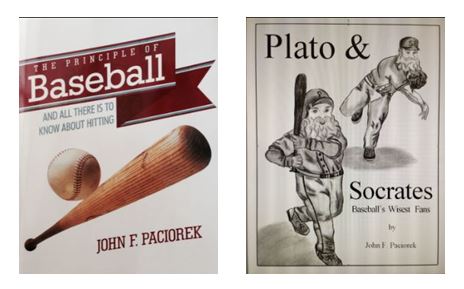 Paciorek, by the way, went on to become a high school teacher and multi-sport coach and is the author of four books (Plato and Socrates – Baseball’s Wisest Fans; The Principles of Baseball: And All There Is To Know About Hitting; and If I Knew Then What I Know Now. You also can enjoy Paciorek’s prose (and expertise) directly at his blog “Paciorek’s Principles of Perfect Practice” by clicking here. You can find out even more about Paciorek in Steven Wagner’s 2015 book “Perfect: The Rise and Fall of John Paciorek, Baseball’s Greatest One-Game Wonder.” (See the review of “Perfect” by clicking here.)
Paciorek, by the way, went on to become a high school teacher and multi-sport coach and is the author of four books (Plato and Socrates – Baseball’s Wisest Fans; The Principles of Baseball: And All There Is To Know About Hitting; and If I Knew Then What I Know Now. You also can enjoy Paciorek’s prose (and expertise) directly at his blog “Paciorek’s Principles of Perfect Practice” by clicking here. You can find out even more about Paciorek in Steven Wagner’s 2015 book “Perfect: The Rise and Fall of John Paciorek, Baseball’s Greatest One-Game Wonder.” (See the review of “Perfect” by clicking here.)
A final note. John Paciorek’s insight into the national pastime should come as no surprise. Paciorek comes from a true “baseball family.” He was the first born of eight siblings and was followed to the big leagues by younger brothers Jim and Tom Paciorek. (Like John, Jim’s MLB career was short – 48 games for the Brewers in 1987. Brother Tom, however, achieved a .282 average over an 18-season MLB career.
 Baseball Roundtable is on the Feedspot list of the Top 100 Baseball Blogs. To see the full list, click here.
Baseball Roundtable is on the Feedspot list of the Top 100 Baseball Blogs. To see the full list, click here.
I tweet (on X) baseball @DavidBaseballRT
Follow/Like Baseball Roundtable’s Facebook Page here. More baseball commentary; blog post notifications; PRIZES.
Member: Society for American Baseball Research (SABR); The Baseball Reliquary; The Negro Leagues Baseball Museum.
